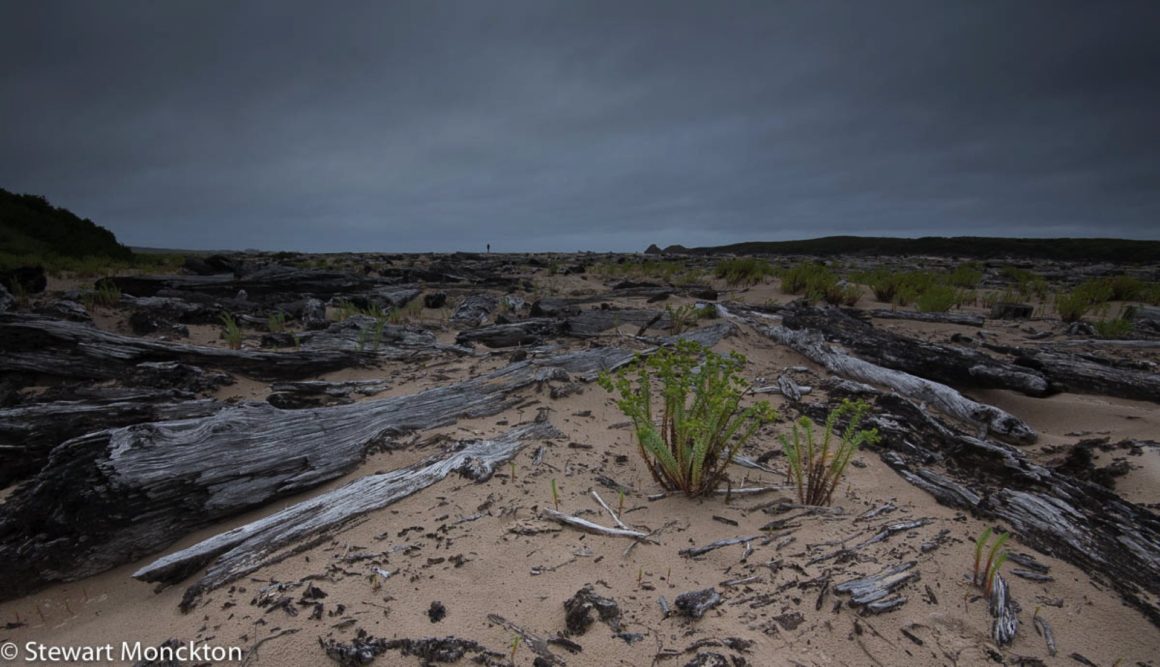The creature is heavy set at one end, with sharp pressure-point teeth at the other. It has a black body the size of a large cat or a small dog, with distinctive white patches. It is curled, sadly, by the side of the road. This is how we see our first Tasmanian Devil and, as we drive past it, I hope it’s not the only one we see.
After passing the sad creature, we enter woodland, close-grown and damp. I keep expecting things to bounce out of the bushes by the side of the road. A few parrots and smaller birds, like wind-blown leaves, rush across the road, but little else. Some say tigers still live here – striped, pouched and thick-tailed, hiding in the darkness. My head reaches a different conclusion about the presence of the Thylacines than my heart does, but both know we are about to enter the realm of the devil.
The small village of Corinna appears suddenly around a corner. The trees step back from the road to create a small open space, and a single and long-abandoned petrol pump acts as a town marker post. Low-slung wooden buildings with tin roofs and soft red-brick chimneys pop up from the grass. An old pushbike leans against a fence, and two fishing rods lean on the bike. The road ends at the Pieman River where a ferry waits for onward travellers. Corinna probably still exists thanks to the Pieman River forcing travellers to pause. We oblige, and decide to spend a few nights here.

When we arrive at our accommodation, a notice outside our front door warns us not to leave our boots outside overnight, lest they be eaten by the devils. A note by the back door could have alerted us to the minefield of wallaby droppings and the presence of sun-worshipping snakes. Devils to the front, snakes to the rear. Splendid.
The next day, the Pieman River becomes our focus. Under gun-metal skies, we tour down the river in a veteran old lady of a boat – the Arcadia II – built from a fine, honey-coloured timber called Huon Pine. As we reach the mouth of the Pieman, we can see a small settlement and a beach overlooking the ocean. It is a place to wonder at the wildness that existed here before rubber boots grew on trees, before the sound of boat motors came loud on the wind and before the click of camera shutters became a proxy for memory. On the far bank of the river, high in the trees, two pale patches resolve into White-bellied Sea Eagles. My thoughts on the return journey are full of wildness and wilderness – full of the fitful movement of wind-blown plants and the slow accumulation of sand.

Back in Corinna, we visit the main hub: the combined bar, restaurant and shop that sits just before the road ends and becomes a river. A veranda wraps around two sides of the building with views towards the river. We play a few games of quoits and, as it becomes evening, we begin the tick-tock tick-tock of table tennis. This is a father and son game, and I now have to concentrate like never before as day-by-day my son’s head grows past my shoulder.
As I’m returning a shot, I notice movement in the darkness of the car park below. A patch of darker darkness detaches itself from the shadows and moves with a rolling gait into the slight light of the open space in front of the ferry. ‘Devil,’ I call, a little too loud, dropping the bat as my son returns the ball.
The dark shape freezes in the middle of the car park and seems to be waiting. I raise my camera, more in hope than anticipation, but the devil moves on through the car park, skilfully avoiding the few pools of light that may have given my camera some hope of focus. It pauses to sniff the night air. Despite the wood smoke and cooking smells, I know it can sense me. The devil enters the dark shadows of the scrubby woodland and disappears. It seems to merge into the darkness rather than leave it. When you see things like this, you can imagine how tales of shape-shifters and magical animals began.

The shift happening today is much sadder. Across much of this island state, the Tasmanian wild is being robbed of its last large carnivore. A facial cancer, fatal and specific, has spread rapidly through the population of devils. Unlike most cancers, this one spreads by contact between devils. When a devil with a tumour bites another, there is a chance that some of the tumour cells will be transferred to the healthy one.
Tumours form around the devil’s face and prevent it from feeding until it starves to death. The cancer has reduced the devils to near extinction in many places. Only on the West Coast do they remain common. Is it due to isolation or due to some genetic difference in these western devils that keeps them safe? We don’t know, but every day brings a real threat that whatever barrier keeps the cancer at bay will be breached and this last stronghold will fall.
As I look into the sundered darkness where a devil once stood, I hope they will remain and persist in the wild. It’s hard to find optimism some days, but I always have sympathy for the devils.
This article was originally published on Paying Ready Attention and is republished here with permission.
Banner image courtesy of Stewart Monckton.


Leave a Reply